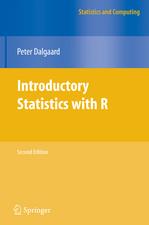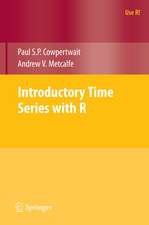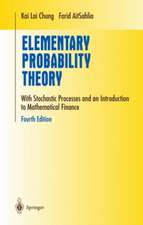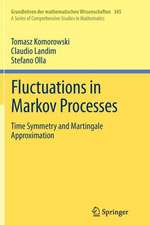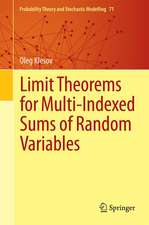Linear Mixed-Effects Models Using R: A Step-by-Step Approach: Springer Texts in Statistics
Autor Andrzej Gałecki, Tomasz Burzykowskien Limba Engleză Hardback – 5 feb 2013
| Toate formatele și edițiile | Preț | Express |
|---|---|---|
| Paperback (1) | 591.94 lei 6-8 săpt. | |
| Springer – 6 mar 2015 | 591.94 lei 6-8 săpt. | |
| Hardback (1) | 849.62 lei 6-8 săpt. | |
| Springer – 5 feb 2013 | 849.62 lei 6-8 săpt. |
Din seria Springer Texts in Statistics
- 15%
 Preț: 559.21 lei
Preț: 559.21 lei - 18%
 Preț: 903.62 lei
Preț: 903.62 lei -
 Preț: 359.53 lei
Preț: 359.53 lei - 18%
 Preț: 695.28 lei
Preț: 695.28 lei -
 Preț: 477.28 lei
Preț: 477.28 lei - 20%
 Preț: 700.50 lei
Preț: 700.50 lei - 20%
 Preț: 717.69 lei
Preț: 717.69 lei -
 Preț: 400.59 lei
Preț: 400.59 lei - 20%
 Preț: 567.29 lei
Preț: 567.29 lei - 20%
 Preț: 633.81 lei
Preț: 633.81 lei - 19%
 Preț: 546.32 lei
Preț: 546.32 lei - 20%
 Preț: 697.47 lei
Preț: 697.47 lei - 15%
 Preț: 676.86 lei
Preț: 676.86 lei - 19%
 Preț: 571.78 lei
Preț: 571.78 lei - 17%
 Preț: 525.26 lei
Preț: 525.26 lei - 20%
 Preț: 643.53 lei
Preț: 643.53 lei - 17%
 Preț: 428.39 lei
Preț: 428.39 lei - 13%
 Preț: 487.07 lei
Preț: 487.07 lei - 20%
 Preț: 764.91 lei
Preț: 764.91 lei -
 Preț: 269.47 lei
Preț: 269.47 lei - 15%
 Preț: 650.86 lei
Preț: 650.86 lei -
 Preț: 403.75 lei
Preț: 403.75 lei -
 Preț: 403.37 lei
Preț: 403.37 lei - 15%
 Preț: 578.67 lei
Preț: 578.67 lei - 19%
 Preț: 626.92 lei
Preț: 626.92 lei - 18%
 Preț: 948.29 lei
Preț: 948.29 lei - 18%
 Preț: 746.59 lei
Preț: 746.59 lei -
 Preț: 500.46 lei
Preț: 500.46 lei -
 Preț: 394.71 lei
Preț: 394.71 lei - 18%
 Preț: 946.69 lei
Preț: 946.69 lei - 15%
 Preț: 702.54 lei
Preț: 702.54 lei -
 Preț: 407.01 lei
Preț: 407.01 lei - 18%
 Preț: 895.89 lei
Preț: 895.89 lei - 15%
 Preț: 600.80 lei
Preț: 600.80 lei - 23%
 Preț: 684.77 lei
Preț: 684.77 lei - 19%
 Preț: 543.05 lei
Preț: 543.05 lei - 15%
 Preț: 595.86 lei
Preț: 595.86 lei -
 Preț: 423.18 lei
Preț: 423.18 lei - 15%
 Preț: 656.10 lei
Preț: 656.10 lei - 15%
 Preț: 682.90 lei
Preț: 682.90 lei - 18%
 Preț: 814.43 lei
Preț: 814.43 lei -
 Preț: 402.76 lei
Preț: 402.76 lei -
 Preț: 408.54 lei
Preț: 408.54 lei - 18%
 Preț: 759.52 lei
Preț: 759.52 lei - 15%
 Preț: 600.80 lei
Preț: 600.80 lei
Preț: 849.62 lei
Preț vechi: 1036.12 lei
-18% Nou
Puncte Express: 1274
Preț estimativ în valută:
162.57€ • 170.20$ • 134.52£
162.57€ • 170.20$ • 134.52£
Carte tipărită la comandă
Livrare economică 05-19 aprilie
Preluare comenzi: 021 569.72.76
Specificații
ISBN-13: 9781461438991
ISBN-10: 1461438993
Pagini: 576
Ilustrații: XXXII, 542 p. 64 illus.
Dimensiuni: 155 x 235 x 36 mm
Greutate: 0.98 kg
Ediția:2013
Editura: Springer
Colecția Springer
Seria Springer Texts in Statistics
Locul publicării:New York, NY, United States
ISBN-10: 1461438993
Pagini: 576
Ilustrații: XXXII, 542 p. 64 illus.
Dimensiuni: 155 x 235 x 36 mm
Greutate: 0.98 kg
Ediția:2013
Editura: Springer
Colecția Springer
Seria Springer Texts in Statistics
Locul publicării:New York, NY, United States
Public țintă
GraduateCuprins
Introduction.- Linear Models for Independent Observations.- Linear Fixed-effects Models for Correlated Data.- Linear Mixed-effects Models.
Recenzii
From the reviews:
Overall, this is very well-written book that covers both LMs and LMMs. Most of the R codes have been checked and work well. The R package nlmeU created by the authors provides great convenience for readers to explore the data in the textbook. Given the extensive applications of LM and LMM, the book should be very appealing to the readers of Technometrics.
Techonometrics, 56:1 2014
“This textbook is built as a step by step incremental description of a modelling tool used extensively in the analysis of hierarchical structured data sets. It is a balanced collection of concepts and examples from various research areas … . In addition to a great collection of theory and examples, a state of the art description of LMMs in R, the authors developed the R package nlmeU which contains the data sets and presented R code, making this book a milestone in its field.” (Irina Ioana Mohorianu, zbMATH, Vol. 1275, 2014)
“Linear Mixed-effects Models Using R byAndrzej Galecki and Tomasz Burzkowski, published by Springer is a book that covers in dept a lot of material on linear models. The book has clear instructions on how to program in R. … This is a good reference book.” (Cats and Dogs with Data, maryannedata.wordpress.com, August, 2013)
Overall, this is very well-written book that covers both LMs and LMMs. Most of the R codes have been checked and work well. The R package nlmeU created by the authors provides great convenience for readers to explore the data in the textbook. Given the extensive applications of LM and LMM, the book should be very appealing to the readers of Technometrics.
Techonometrics, 56:1 2014
“This textbook is built as a step by step incremental description of a modelling tool used extensively in the analysis of hierarchical structured data sets. It is a balanced collection of concepts and examples from various research areas … . In addition to a great collection of theory and examples, a state of the art description of LMMs in R, the authors developed the R package nlmeU which contains the data sets and presented R code, making this book a milestone in its field.” (Irina Ioana Mohorianu, zbMATH, Vol. 1275, 2014)
“Linear Mixed-effects Models Using R byAndrzej Galecki and Tomasz Burzkowski, published by Springer is a book that covers in dept a lot of material on linear models. The book has clear instructions on how to program in R. … This is a good reference book.” (Cats and Dogs with Data, maryannedata.wordpress.com, August, 2013)
Notă biografică
Andrzej Gałecki is a Research Professor in the Division of Geriatric Medicine, Department of Internal Medicine, and Institute of Gerontology at the University of Michigan Medical School, and is Research Scientist in the Department of Biostatistics at the University of Michigan School of Public Health. He earned his M.Sc. in applied mathematics (1977) from the Technical University of Warsaw, Poland, and an M.D. (1981) from the Medical University of Warsaw. In 1985 he earned a Ph.D. in epidemiology from the Institute of Mother and Child Care in Warsaw (Poland). He is a member of the Editorial Board of the Open Journal of Applied Sciences. Since 1990, Dr. Galecki has collaborated with researchers in gerontology and geriatrics. His research interests lie in the development and application of statistical methods for analyzing correlated and over- dispersed data. He developed the SAS macro NLMEM for nonlinear mixed-effects models, specified as a solution to ordinary differential equations. He also proposed a general class of variance-covariance structures for the analysis of multiple continuous dependent variables measured over time. This methodology is considered to be one of first approaches to joint models for longitudinal data.
Tomasz Burzykowski is Professor of Biostatistics and Bioinformatics at Hasselt University (Belgium) and Vice-President of Research at the International Drug Development Institute (IDDI) in Louvain-la-Neuve (Belgium). He received the M.Sc. degree in applied mathematics (1990) from Warsaw University, and the M.Sc. (1991) and Ph.D. (2001) degrees from Hasselt University. He has held guest professorships at the Karolinska Institute (Sweden), the Medical University of Bialystok (Poland), and the Technical University of Warsaw (Poland). He serves as Associate Editor of Biometrics. Dr. Burzykowski published methodological work on survival analysis, meta-analyses of clinical trials, validation of surrogate endpoints, analysis of gene expression data, and modelling of peptide-centric mass-spectrometry data. He is also a co-author of numerous papers applying statistical methods to clinical data in different disease areas.
Tomasz Burzykowski is Professor of Biostatistics and Bioinformatics at Hasselt University (Belgium) and Vice-President of Research at the International Drug Development Institute (IDDI) in Louvain-la-Neuve (Belgium). He received the M.Sc. degree in applied mathematics (1990) from Warsaw University, and the M.Sc. (1991) and Ph.D. (2001) degrees from Hasselt University. He has held guest professorships at the Karolinska Institute (Sweden), the Medical University of Bialystok (Poland), and the Technical University of Warsaw (Poland). He serves as Associate Editor of Biometrics. Dr. Burzykowski published methodological work on survival analysis, meta-analyses of clinical trials, validation of surrogate endpoints, analysis of gene expression data, and modelling of peptide-centric mass-spectrometry data. He is also a co-author of numerous papers applying statistical methods to clinical data in different disease areas.
Textul de pe ultima copertă
Linear mixed-effects models (LMMs) are an important class of statistical models that can be used to analyze correlated data. Such data are encountered in a variety of fields including biostatistics, public health, psychometrics, educational measurement, and sociology. This book aims to support a wide range of uses for the models by applied researchers in those and other fields by providing state-of-the-art descriptions of the implementation of LMMs in R. To help readers to get familiar with the features of the models and the details of carrying them out in R, the book includes a review of the most important theoretical concepts of the models. The presentation connects theory, software and applications. It is built up incrementally, starting with a summary of the concepts underlying simpler classes of linear models like the classical regression model, and carrying them forward to LMMs. A similar step-by-step approach is used to describe the R tools for LMMs. All the classes of linearmodels presented in the book are illustrated using real-life data. The book also introduces several novel R tools for LMMs, including new class of variance-covariance structure for random-effects, methods for influence diagnostics and for power calculations. They are included into an R package that should assist the readers in applying these and other methods presented in this text.
Andrzej Gałecki is a Research Professor in the Division of Geriatric Medicine, Department of Internal Medicine, and Institute of Gerontology at the University of Michigan Medical School, and is Research Scientist in the Department of Biostatistics at the University of Michigan School of Public Health. He earned his M.Sc. in applied mathematics (1977) from the Technical University of Warsaw, Poland, and an M.D. (1981) from the Medical University of Warsaw. In 1985 he earned a Ph.D. in epidemiology from the Institute of Mother and Child Care in Warsaw (Poland). He is a member of the Editorial Board of the Open Journal of Applied Sciences. Since 1990, Dr. Galecki has collaborated with researchers in gerontology and geriatrics. His research interests lie in the development and application of statistical methods for analyzing correlated and over- dispersed data. He developed the SAS macro NLMEM for nonlinear mixed-effects models, specified as a solution to ordinary differential equations. He also proposed a general class of variance-covariance structures for the analysis of multiple continuous dependent variables measured over time. This methodology is considered to be one of first approaches to joint models for longitudinal data.
Tomasz Burzykowski is Professor of Biostatistics and Bioinformatics at Hasselt University (Belgium) and Vice-President of Research at the International Drug Development Institute (IDDI) in Louvain-la-Neuve (Belgium). He received the M.Sc. degree in applied mathematics (1990) from Warsaw University, and the M.Sc. (1991) and Ph.D. (2001)degrees from Hasselt University. He has held guest professorships at the Karolinska Institute (Sweden), the Medical University of Bialystok (Poland), and the Technical University of Warsaw (Poland). He serves as Associate Editor of Biometrics. Dr. Burzykowski published methodological work on survival analysis, meta-analyses of clinical trials, validation of surrogate endpoints, analysis of gene expression data, and modelling of peptide-centric mass-spectrometry data. He is also a co-author of numerous papers applying statistical methods to clinical data in different disease areas.
Andrzej Gałecki is a Research Professor in the Division of Geriatric Medicine, Department of Internal Medicine, and Institute of Gerontology at the University of Michigan Medical School, and is Research Scientist in the Department of Biostatistics at the University of Michigan School of Public Health. He earned his M.Sc. in applied mathematics (1977) from the Technical University of Warsaw, Poland, and an M.D. (1981) from the Medical University of Warsaw. In 1985 he earned a Ph.D. in epidemiology from the Institute of Mother and Child Care in Warsaw (Poland). He is a member of the Editorial Board of the Open Journal of Applied Sciences. Since 1990, Dr. Galecki has collaborated with researchers in gerontology and geriatrics. His research interests lie in the development and application of statistical methods for analyzing correlated and over- dispersed data. He developed the SAS macro NLMEM for nonlinear mixed-effects models, specified as a solution to ordinary differential equations. He also proposed a general class of variance-covariance structures for the analysis of multiple continuous dependent variables measured over time. This methodology is considered to be one of first approaches to joint models for longitudinal data.
Tomasz Burzykowski is Professor of Biostatistics and Bioinformatics at Hasselt University (Belgium) and Vice-President of Research at the International Drug Development Institute (IDDI) in Louvain-la-Neuve (Belgium). He received the M.Sc. degree in applied mathematics (1990) from Warsaw University, and the M.Sc. (1991) and Ph.D. (2001)degrees from Hasselt University. He has held guest professorships at the Karolinska Institute (Sweden), the Medical University of Bialystok (Poland), and the Technical University of Warsaw (Poland). He serves as Associate Editor of Biometrics. Dr. Burzykowski published methodological work on survival analysis, meta-analyses of clinical trials, validation of surrogate endpoints, analysis of gene expression data, and modelling of peptide-centric mass-spectrometry data. He is also a co-author of numerous papers applying statistical methods to clinical data in different disease areas.
Caracteristici
This book provides a description of the most important theoretical concepts and features of linear mixed models (LMMs) and their implementation in R All the classes of linear models presented in the book are illustrated using real-life data Provides information crucial to data from many fields including biostatistics, public health, psychometrics, educational measurement, and sociology A step-by-step approach is used to describe the R tools for LMMs Includes supplementary material: sn.pub/extras



